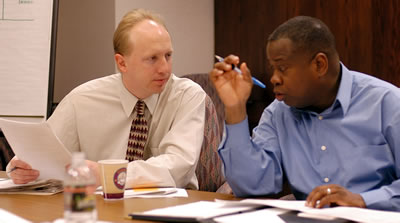|
By Jeanne Aamodt
Editor’s note: This is one in a series of articles featuring Mn/DOT employees on the job. Do you or a co-worker have an interesting job to share with readers? Use the “Submissions” button on the left navigation bar, or click here to send us your ideas, and we’ll contact you for more information.

Brad Larsen (left) listens to John Tompkins, Office of Freight and Commercial Vehicle Operations, during a planning meeting for the MIssissippi Valley Conference which Mn/DOT is hosting this summer. Photo by David Gonzalez |
It’s been two-plus years on the job and not a day has been the same, says Brad Larsen, Mn/DOT's federal relations manager in the Office of Government Affairs. He was appointed to the position in December 2004, after having spent eight years in the Office of Investment Management.
In his current role, Larsen serves as the agency’s principal contact with the members of Minnesota’s congressional delegation and their staffs. His major responsibilities also include serving as liaison on transportation issues with Gov. Tim Pawlenty’s office in Washington, D.C.
Larsen has both a law degree and a master’s degree in public administration.
What attracted you to the federal side of Government Affairs?
I knew what the job involved because of my history in Investment Management. I was drawn to the area of federal funding and national transportation policy. Al Schenkelberg, office director at the time and a real mentor, encouraged my interest. I was also familiar with federal government, having worked as a college student for U.S. Sen. Kent Conrad of North Dakota.
What do you mean when you say ‘no day is ever the same’?
Federal relations work is fast-moving and involves a lot of variety. I have to get smart quick on a lot of subjects. On any given day I am responding to inquiries, interpreting federal legislation, preparing the lieutenant governor, deputy commissioner and division directors for national hearings, coordinating Minnesota’s involvement with the American Association of State Transportation Officials or arranging meetings between Mn/DOT district engineers and our congressional delegation in Washington, D.C. These activities keep me busy enough that I am considering establishing a mobility position to help in the future.
What does it take to be successful?
Building relations and becoming a trusted source of information are the keys to the job, and good communication is the foundation for success.
What’s the biggest challenge you’ve faced so far?
Dealing with the political environment is a big challenge and timing can be everything. For example, I released Mn/DOT’s position on federal earmarks to the Minnesota congressional delegation just days before a meeting with U.S. Rep. James Oberstar, who has brought millions of earmark dollars to Minnesota. Let’s just say that our position doesn't exactly mirror his and the matter was fresh on his mind when we met.
What’s the future look like for federal funding for state and local roads?
The future is very unpredictable, and I don’t have a crystal ball to help me see past 2009, when the current federal funding bill expires.
The good news is that there are a lot of potential opportunities. For example, next month Mn/DOT and the Center for Transportation Studies are hosting a field hearing before the National Surface Transportation Policy and Revenue Study Commission. This commission was established under SAFETEA-LU (the federal transportation legislation passed in 2005) to develop congressional recommendations for a future national transportation policy.
Many hope this commission will play the same role as the Clay Commission played 50 years ago in the development of the interstate highway system. The next federal transportation reauthorization bill could be revolutionary in many different ways.
As a kid, did you ever imagine you’d become a policy wonk?
I don’t think I had a clue. I was originally drawn to the traditional sciences. I first majored in physics at Bemidji State University —it went real well the first year, until pre-law courses caught my attention. College really opened up my horizons. I changed course and political science became my major. I’m not sure why they call it a science, from what I’ve seen it’s more of an art.
Previous on-the-job feature:
|



